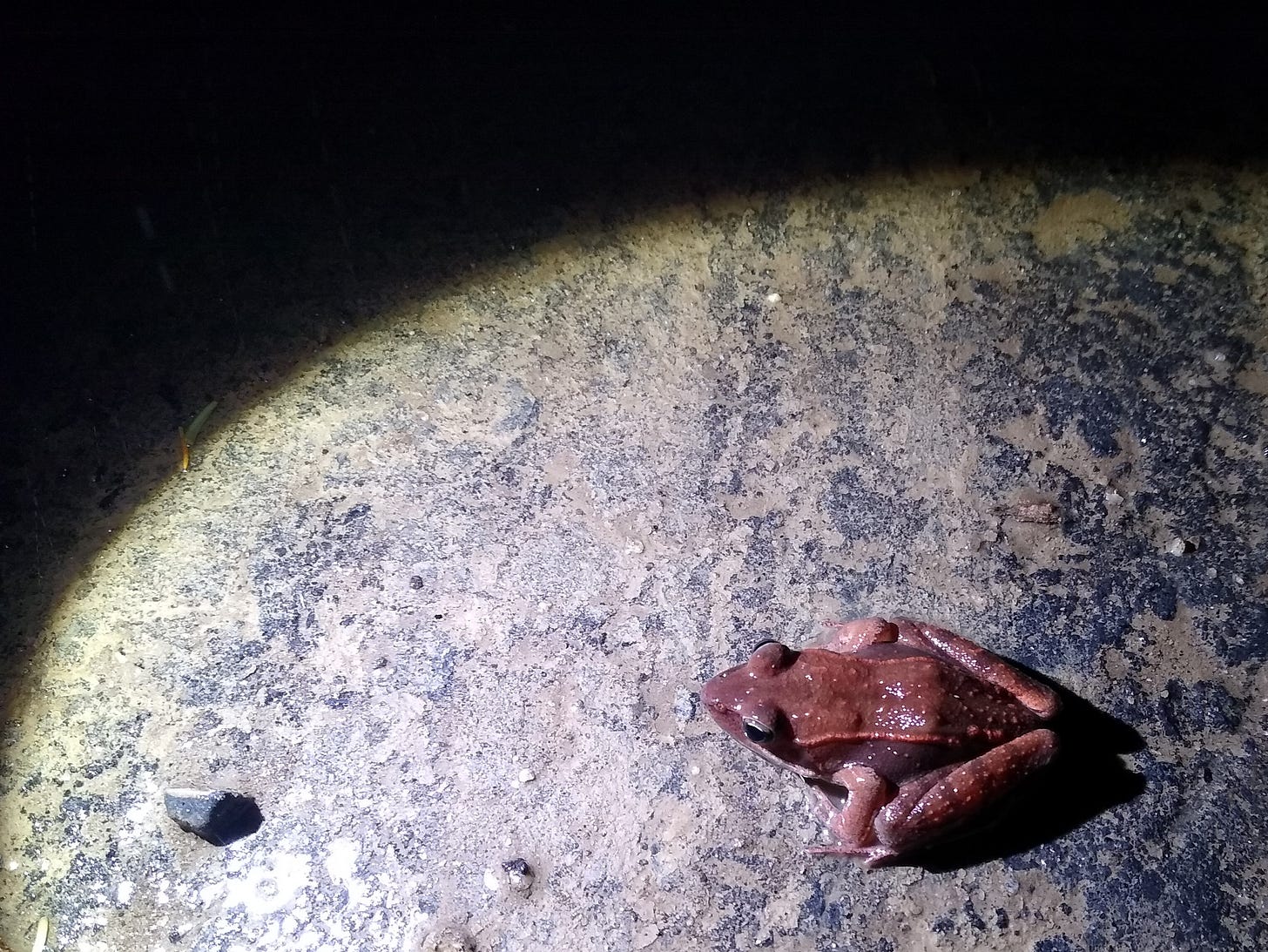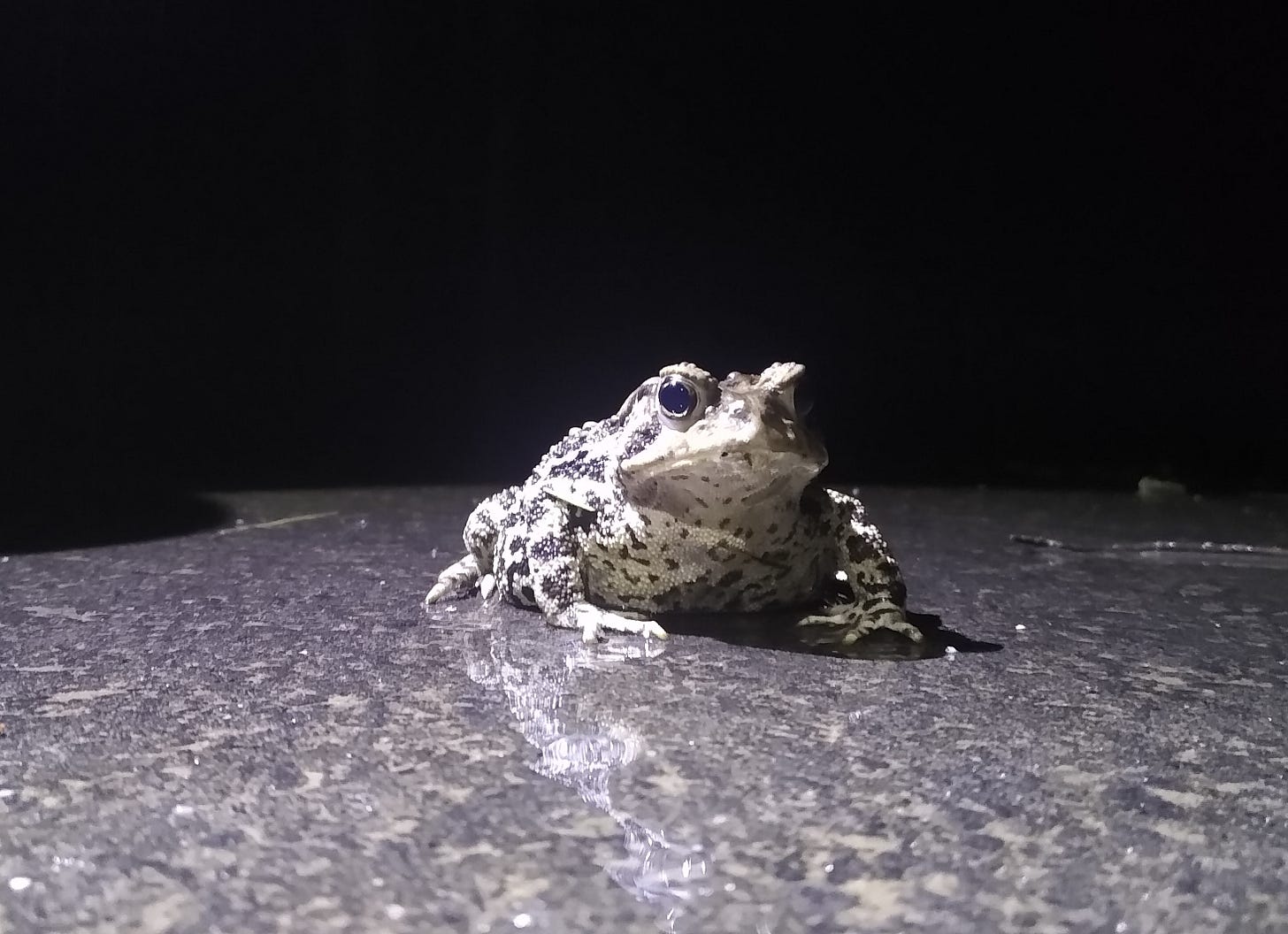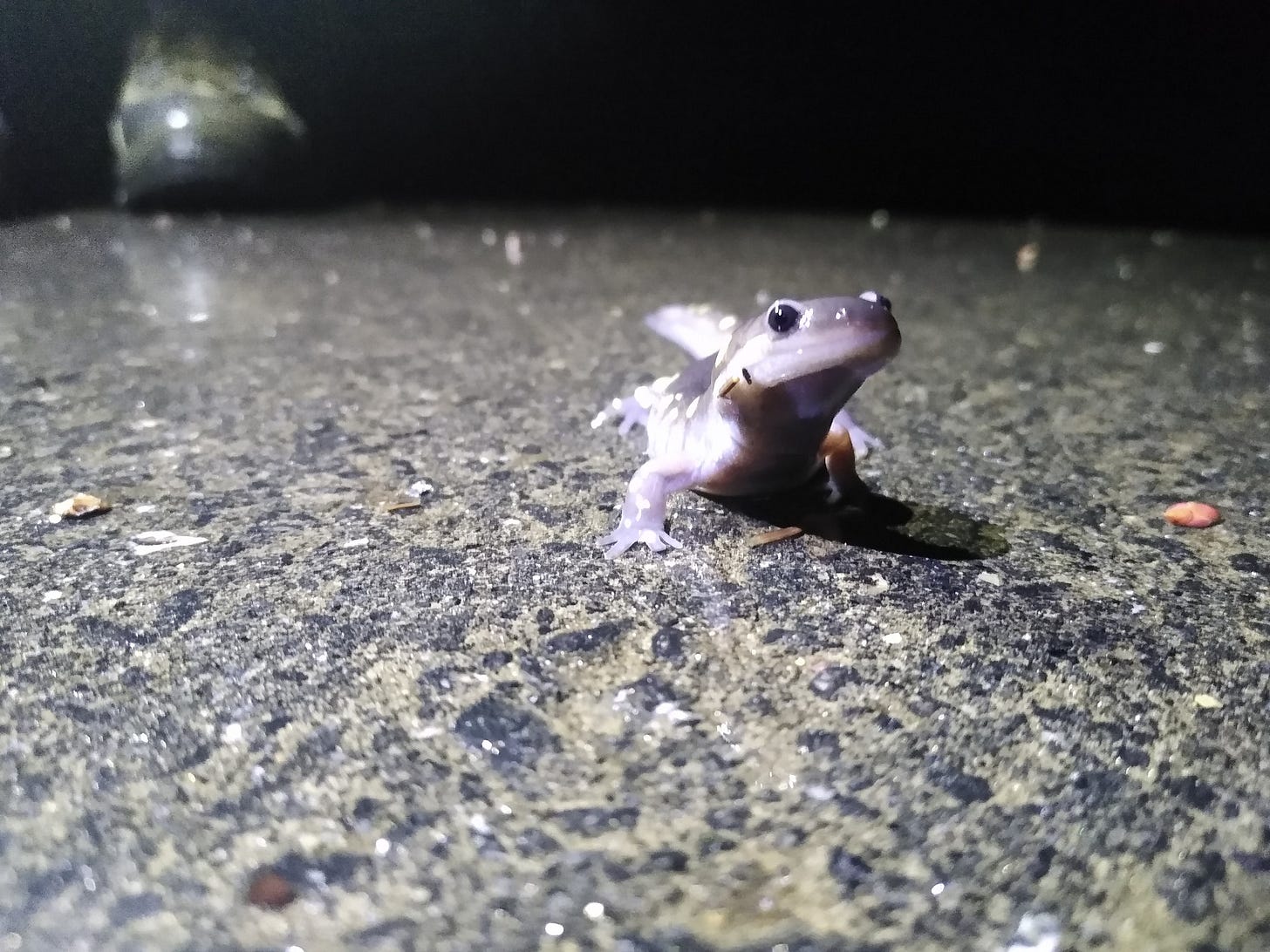A Break and Some Upbeat News
4/27/23 – An easier week as we welcome Spring
Hello everyone:
I’ve taken a bit of a break this week, enjoying spring (much of it drizzly and 45°F…), starting to plant the vegetable garden, and catching up on other work. I’m offering up a flock of good Anthropocene news, plus a few photos from our two Big Night excursions (helping frogs and salamanders cross the road on their late-night rainy Spring booty calls).
If you’re motivated to go a little deeper into the reader/writer ecosystem here on Substack, you might check out the new feature they’re calling Notes. It’s a short-form post-and-comment social media thing, sort of like Twitter but without any of the dumpster fire: no ads, algorithms, or maladjusted billionaires. Notes is contained within Substack, so you’re not drinking from the hydrant of global news and lunch photographs.
Instead, you can either see what anyone is posting on Notes on the Home tab, or limit what you’re seeing to just the writers you’ve subscribed to (the Subscribed tab). To join the conversation, you can post to Notes in a variety of ways that the link above will explain. This includes “Restacking,” which is their awkward term for copying-and-pasting a clip of text from a Substack post and commenting on it.
Or you can simply promote a favorite writer. At the risk of flattering myself, here’s an example in the form of a lovely comment from Rosie Sherwood, eco-artist, writer, soon-to-be van adventurer, and a reader of the Field Guide. (Check out her Substack, A Nomadic Rose.)
I’ll be back at the writing next week as we start the third year of the Field Guide together. Next week’s topic might be avian flu’s impact on wild bird populations, or the SUV problem, or explaining the climate impacts of the El Nino heading our way, or… something else. Stay tuned!
Without further ado, then, here’s a chunkier-than-normal collection of curated Anthropocene news.
It’s time for No Mow May. Where you live will set the schedule, but the basic ecological truths are simple and solid: 1) spring pollinators need every flower they can find, including the little ones trying to grow in your lawn; 2) we don’t need to mow as often and as close to the ground as we think we do; 3) we often don’t need to mow as much of our lawn as we usually do, and the more you can let go or plant with native flowers the better environmental steward you’ll be; 4) a taller lawn grows better roots, withstands droughts better, and hosts a life-sustaining array of invertebrates; 5) less mowing = less noise and air pollution, and provides you more free time; and 6) pesticides and herbicides are poisons, and the world needs less poisons. The link above from Bee City USA is an excellent source of information, as is this article from the Post.
From Bill McKibben’s Crucial Years column, the really big (and good!) news from the Supreme Court, which declined to allow fossil fuel companies to move the many climate-change-damage lawsuits coming from cities and states into federal court. As McKibben notes, the prospect of a flood of these lawsuits “freaked out the industry, because it could see one possible future: a series of judgments large enough to bring it, like the tobacco industry, to its knees, forced to make some kind of general settlement just to stay in business.” For a broader view of the decision, E&E News has a good overview.
Here's a favorite artist, Rod MacIver, and his beautiful images, on his Heron Dance site. Rod has recently started a Substack too, which he describes as “Art and words that celebrate the beauty and mystery of creation, and of the creative journey.”
From Nautilus, a really lovely account of studying penguins in Antarctica by Naira de Gracia, who left behind an urban childhood to do ecological fieldwork in remote areas around the Earth. I love what she says here about feeling the “resident ecology muffled under layers of concrete”:
As a kid I moved through so many big cities that they all started to feel the same – busy streets, multistory buildings, the bustle of people, subway trains, the same transnational brands occupying city corners. I felt the resident ecology muffled under layers of concrete. A sense of place rooted in other species felt disparate and elusive. I was ever peeking at the weeds that grew from the cracks in the sidewalk, trying to catch a glimpse of the birds that flitted around in urban trees, growing cherry tomatoes in containers on cement patios.
When I started working in the field, I felt nested within a web of other species, grounded in place and biome in a way I’d always wanted to be.
From the Climate Coach at the Post, a really nice and quick review of four excellent naturalist apps for your phone: Merlin, iNaturalist, Pl@ntNet, and Seek. Many of you may be familiar with these apps, but what I like about the review is that it’s not simply talking about how we experience the technology. Much more importantly, the apps have a role to play in reconnecting us to the natural world. Learn the plant names, the bird songs, or the habits of the myriad iridescent beetles crossing your path, and suddenly you have relationships with neighbors in a community that we called home for nearly all of human history. Now we spend 90% of our time indoors, much of it on screens like this one.
From Yale e360, the end is nigh for the era of big dam construction. Costs, reliability issues in a world of increased heat and drought, competition from wind and solar, and opposition from environmentalists and local residents have made dams less and less tenable. Also, so much of the world’s riverine habitat has been dammed that few good locations are left for the kind of megadams that have marked the last several decades.
From David Roberts at his podcast Volts, a conversation with two experts about how environmental groups, especially those located in communities of color and other highly-impacted areas, make the most use of the extraordinary funding opportunities made possible by the Inflation Reduction Act. What Roberts says here about potential IRA funding being much, much greater than was first assumed is really exciting:
The total amount of federal money that will be spent on climate solutions via the IRA will be determined not by any preset limit, but by demand for the tax credits. The more qualified applicants that seek them, the more will be spent. The Congressional Budget Office estimated the bill’s spending at $391 billion, but a report last year from Credit Suisse put the number at $800 billion and a more recent Goldman Sachs report put it closer to $1.2 trillion.
From the Center for Biological Diversity, please take this opportunity to speak up and tell the Forest Service to create a rule protecting mature and old-growth forests from logging. Protecting these forests are essential for both the biodiversity and climate crises. While you’re at it, sign up for one of their newsletters, which offer a great mix of insights and good news stories from their battles to protect life on Earth.
From the Pew Trusts’ Stateline, an excellent overview of the Green Amendment movement around the U.S. trying to provide state-by-state constitutional protections for citizens’ right to clean air, clean water, and a healthy environment. My readers will remember that I’ve written about this before.
And finally, from the always-wonderful Orion magazine, an interview with Barbara Kingsolver on “mothering, farming, ecology, and life.” Everything she says is smart and fascinating:
Among the scholars who study such things, it’s well known that on average, conservatives are happier than liberals. I think we’re seeing a deficit of wonder in many well-meaning hearts. I live in a deep red part of the country, and while I don’t vote the same way as a lot of my neighbors, I love and admire them for the joy they take in family, community, and spiritual celebration. We don’t judge each other here for unabashed happiness at the sight of a baby or a great meal or a bright blue bird in a hayfield. Maybe your mind jumped straight to: “that baby born to a dim future… the bluebird threatened by climate change… that meal when others are going hungry…” Which is as useful as our mothers once shaming us to eat, because children in China were starving. I always thought, “But I can’t mail it to them, can I?” We have to be allowed to rejoice in our own lives, to appreciate the value of life in general. We’ll work to save what we love.
Thanks for sticking with me.







Thanks for the nice mention Jason. Love the Big Night photos. What a brilliant thing to happen in the world every year.
Help those little folk cross the road! I do the same with the earthworms!
Out here watching part of the great spring migration of little Shorebirds winging north to the Arctic. Flock after flock past the window of our beachfront lodging. An ancient thing of enormous beauty goodness majesty. A planet with just birds and no people wouldn't be a bad thing necessarily. Our only redeeming quality is we do have the capacity for a compassion that goes out to help toads and earthworms cross our roads.